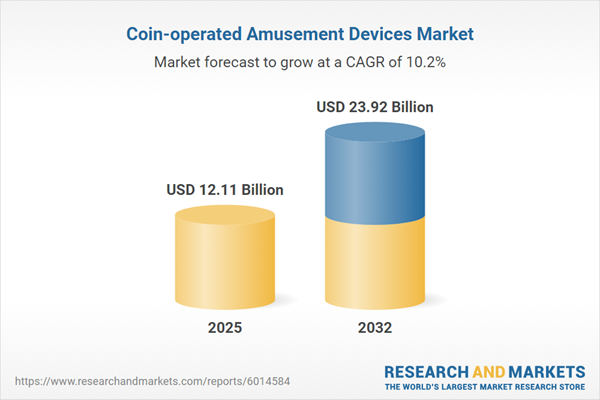Speak directly to the analyst to clarify any post sales queries you may have.
The coin-operated amusement devices market is transforming public recreation by seamlessly integrating new technologies with evolving consumer preferences. Senior executives are steering this dynamic landscape to optimize operational outcomes and cultivate engaging entertainment experiences that attract a broad spectrum of patrons.
Market Snapshot: Coin-Operated Amusement Devices Market Overview
The coin-operated amusement devices market is undergoing significant growth, with established players collaborating alongside new entrants to drive overall sector advancement. Strategic investment in digital solutions supports the modernization of classic formats, ensuring venues remain current while honoring the enduring appeal of traditional games and entertainment. Continuous product improvement—across both hardware and software—empowers operators to respond effectively to market shifts and changing preferences. As venues diversify to enhance guest satisfaction, the market remains adaptable and positioned for continued upward momentum.
Scope & Segmentation
- Product Types: Mechanical amusement games, digital jukeboxes, classic jukeboxes, children’s simulators, carousel rides, redemption ticket machines, multi-genre video games, and both enclosed and open-air photo booths provide versatile offerings for a wide range of entertainment environments.
- Location Types: Amusement parks, arcades, bars, pubs, malls, quick service restaurants, and family entertainment centers all benefit from tailored device installations that boost guest engagement and upgrade venue ambiance.
- Distribution Channels: Direct sales, trade shows, value-added distributors, digital commerce platforms, and manufacturer websites streamline market entry and simplify ongoing inventory management for both newcomers and experienced operators.
- Payment Modes: Coin mechanisms, card readers, mobile payment solutions, and token-based systems address a broad variety of user preferences and support flexible operational strategies.
- Regions Covered: Providers serve the Americas, Europe, Middle East, Africa, and Asia-Pacific. Specific countries—including the United Kingdom, United Arab Emirates, South Africa, China, India, Japan, Australia, and South Korea—require regionally nuanced strategies and compliance with distinct regulatory and cultural standards.
- Leading Companies: Major market drivers include Bandai Namco Holdings Inc., Sega Sammy Holdings Inc., Konami Holdings Corporation, Square Enix Holdings Co., Ltd., Raw Thrills, Inc., LAI Games, Bay Tek Games, Adrenaline Amusements, Global VR, and UNIS Co., Ltd., all contributing to international expansion and technological innovation.
Key Takeaways for Senior Decision-Makers
- Implementing artificial intelligence and augmented reality enhances both user personalization and site-level analytics, informing venue strategies and deepening engagement.
- Embracing contactless payments and touch-free user interfaces responds to heightened hygiene expectations, bolstering visitor trust in busy settings.
- Offering portfolios that combine mechanical and digital devices equips operators to flexibly address diverse regional and venue requirements.
- Adaptive business models—using partnerships, licensing, and modular designs—enable rapid response to evolving operational and consumer trends.
- Remote monitoring and analytics minimize downtime, streamline scheduled maintenance, and support proactive marketing and planning decisions.
- Strict attention to regional compliance and regulatory demands is crucial for mitigating operational risk and protecting market position across global segments.
Tariff Impact: Navigating Trade Constraints
Recent U.S. tariff adjustments compel market actors to reassess sourcing and supply chain practices. Emphasizing domestic component procurement and local assembly enables operators to stabilize costs, sustain consistent inventories, and maintain competitive standing despite shifting trade landscapes.
Methodology & Data Sources
The analysis adopts a multi-layered approach, integrating executive interviews, venue assessments, and direct user input. Data is validated with industry publications, financial statements, association data, and regulatory documents, providing stakeholders with actionable insights.
Why This Report Matters
- Structured frameworks support technology integration decisions and streamline resource allocation in response to evolving industry pressures.
- Comprehensive insights help leaders manage supply chains, minimize operational risks, and maintain regulatory compliance in global markets.
- Detailed regional analysis aids in refining operational strategies and aligning with local regulatory requirements for competitive advantage.
Conclusion
The report delivers targeted recommendations to help organizations harness innovation and adaptive business practices, promoting sustainable growth and resilience within the rapidly developing coin-operated amusement devices market.
Additional Product Information:
- Purchase of this report includes 1 year online access with quarterly updates.
- This report can be updated on request. Please contact our Customer Experience team using the Ask a Question widget on our website.
Table of Contents
3. Executive Summary
4. Market Overview
7. Cumulative Impact of Artificial Intelligence 2025
Companies Mentioned
The companies profiled in this Coin-operated Amusement Devices market report include:- Bandai Namco Holdings Inc.
- Sega Sammy Holdings Inc.
- Konami Holdings Corporation
- Square Enix Holdings Co., Ltd.
- Raw Thrills, Inc.
- LAI Games, LLC
- Bay Tek Games, Inc.
- Adrenaline Amusements, LLC
- Global VR, Inc.
- UNIS Co., Ltd.
Table Information
| Report Attribute | Details |
|---|---|
| No. of Pages | 186 |
| Published | November 2025 |
| Forecast Period | 2025 - 2032 |
| Estimated Market Value ( USD | $ 12.11 Billion |
| Forecasted Market Value ( USD | $ 23.92 Billion |
| Compound Annual Growth Rate | 10.2% |
| Regions Covered | Global |
| No. of Companies Mentioned | 11 |









